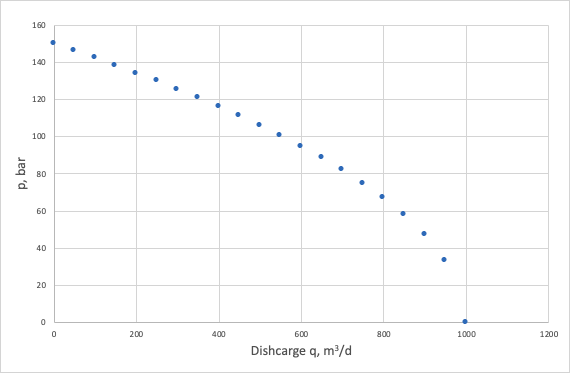The most general Pump model is given as (see Fig. 1):
| (1) | q = q(p_{\rm out}, p_{\rm in}) |
where F(q, p_{\rm in}) is called pump characteristic curve.
The power consumpotion is given by:
| (2) | W(q,p) = \eta(q) \cdot q \cdot (p-p_{\rm in}) |
where
\eta | pump efficiency |
In most practical cases pump characteristic curve has negligible dependence on intake pressure p_{\rm in}:
| (3) | p_{\rm out} = p_{\rm in} + \delta p_{\rm max} \cdot \cdot F(q/q_{\rm max}) |
where F(x =0) = 0 and F(x =1) = 1 .
The pump characteristic curve
F(x) can be usually approximated by the following equation:
| (4) | F(x)= 1 - (1- x^m)^n |
and usually n=0.5 and m=1: F(x)= 1- \sqrt{1- x}.
| Fig. 1. Pump Characteristic Curve |
A popular pump proxy model is given by quadratic equation:
| (5) | q = \frac{q_{\rm max}}{2 \cdot k_f} \cdot \left[ -(1- k_f) + \sqrt{ (1 + k_f)^2 - 4 \cdot k_f \cdot (p- p_{\rm in})/p_{\rm max}) \ } \right] |
| (6) | \eta(q) = 4 \, \eta_{\rm max} \cdot q/q_{\rm max} \cdot ( 1 - q/q_{\rm max}) |
where
p_{\rm max} | maximum pressure gain that pump can exert over the input pressure p_{\rm in} |
|---|---|
q_{\rm max} | maximum flowrate that pump can produce |
k_f | curvature of the pump characteristics (dimensionless) |
\eta | pump efficiency |
\eta_{\rm max} | maximum pump efficiency |
W | electrical consumption per unit time |
See also
Natural Science / Engineering / Device / Pump
